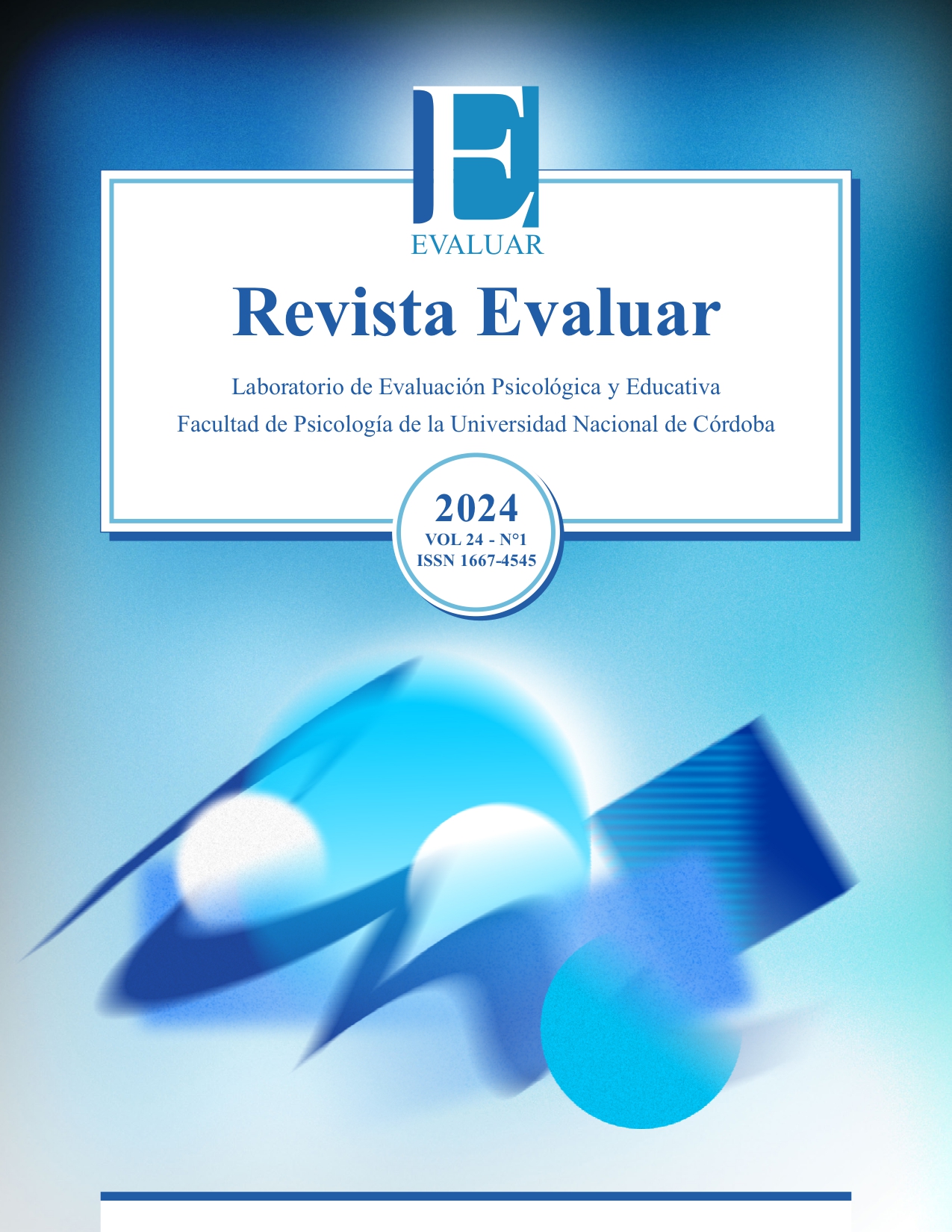Validación de la Escala Fusión Pensamiento-Acción para población Mexicana
DOI:
https://doi.org/10.35670/1667-4545.v24.n1.45161Keywords:
pensamiento fusión-acción, escala de pensamiento fusión-acción, población mexicana, pensamientos intrusivos, trastorno obsesivo-compulsivoAbstract
Fusión pensamiento-acción se refiere a la creencia de que un pensamiento puede causar una acción indeseada o tener consecuencias morales. La Escala de Fusión Pensamiento-Acción (TAFS) evalúa la disfuncionalidad de los pensamientos en que el individuo vincula sus pensamientos con las acciones. La escala cuenta con tres subescalas, TAF-probabilidad -para-uno mismo (TAF-LS), TAF-probabilidad-para-otros (TAF-LO) y la última escala siendo la de TAF-moral (TAF-M). El objetivo de este estudio fue validar la adaptación del TAFS con una muestra de estudiantes universitarios mexicanos. 430 estudiantes universitarios entre 18 a 24 años de edad, de una universidad de México participaron en el estudio (M = 20.59, DE = 1.92). Los resultados mostraron que la estructura original de tres factores tiene un buen ajuste con los datos, lo cual fue consistente con estudios previos realizados con muestra no-clínica. Estos resultados indican una buena consistencia interna y una adaptación adecuada de la prueba original para ser utilizada
con población universitaria mexicana.
Downloads
References
Abramowitz, J. S., Whiteside, S., Lynam, D., & Kalsy, S. (2003). Is thought-action fusion specific to obsessive-compulsive disorder? A mediating role of negative effect. Behaviour Research and Therapy, 41(9), 1069-1079. https://doi.org/10.1016/S0005-7967(02)00243-7
Altın, M., & Gençöz, T. (2010). How does thought-action fusion relate to responsibility attitudes and thought suppression to aggravate the obsessive-compulsive symptoms? Behavioural and Cognitive Psychotherapy, 39(1), 99-114. https://doi.org/10.1017/S1352465810000524
Amir, N., Freshman, M., Ramsey, B., Neary, E., & Bartholomew, B. (2001). Thought-action fusion in individuals with OCD symptoms. Behavioural Research and Therapy, 39(7), 765-776. https://doi.org/10.1016/S0005-7967(00)00056-5
Amir, F. (2017). The relationship between thought action fusion with obsessive compulsive dimensions and severity in adolescents. Indian Journal of Positive Psychology, 8(4), 531-534.
Aydın, A., Boysan, M., Tutarel-Kışlak, S., Kalafat, T., Selvi, Y., & Beşiroğlu, L. (2012). The predictive value of interpersonal schemas, perfectionism and thought action fusion in obsessive compulsive disorder. The Journal of Psychiatry and Neurological Sciences, 25, 108-118. https://doi.org/10.5350/dajpn2012250202
Baer, L. (1991). Getting control: Overcoming obsessions and compulsions. Little Brown.
Bailey, B. E., Wu, K. D., Valentiner, D. P., & McGrath, P. B. (2014). Thought–action fusion: Structure and specificity to OCD. Journal of Obsessive-Compulsive and Related Disorders, 3(1), 39-45. https://doi.org/10.1016/j.jocrd.2013.12.003
Barrera, T. L., & Norton, P. J. (2011). The appraisal of intrusive thoughts in relation to Obsessional–Compulsive symptoms. Cognitive Behaviour Therapy, 40(2), 98-110. https://doi.org/10.1080/16506073.2010.545072
Berman, N. C., Abramowitz, J. S., Wheaton, M. G., Pardue, C., & Fabricant, L. (2011). Evaluation of an in-vivo measure of thought–action fusion. Journal of Cognitive Psychotherapy, 25(2), 155-164. https://doi.org/10.1891/0889-8391.25.2.155
Berle, D., & Starcevic, V. (2005). Thought–action fusion: Review of the literature and future directions. Clinical Psychology Review, 25(3), 263-284. https://doi.org/10.1016/j.cpr.2004.12.001
Caraveo-Anduaga, J., & Colmenares, E. (2004). The epidemiology of obsessive-compulsive disorder in Mexico City. Salud Mental, 27(2), 1-6.
Cougle, J. R., Purdon, C., Fitch, K. E., & Hawkins, K. A. (2013). Clarifying relations between thought-action fusion, religiosity, and obsessive-compulsive symptoms through consideration of intent. Cognitive Therapy and Research, 13(2), 221-231. https://doi.org/10.1007/s10608-012-9461-8
De la Rosa-Gómez, A., Hernández- Posadas, A., Valencia, P. D., & Guajardo-Garcini, D. A. (2021). Análisis dimensional de la Escala de Dificultades en la Regulación Emocional (DERS-15) en universitarios mexicanos. Revista Evaluar, 21(2), 80-97. https://doi.org/10.35670/1667-4545.v21.n2.34401
Gallegos-Guajardo, J., Sanchez-Jauregui, G., Hidalgo, J., Alicea-Lozada, L., Luna-Huguenin, V., & Fisak, B. (2020). Validation of the White Bear Suppression Inventory for the Mexican population. Manuscript submitted for publication. https://doi.org/10.35670/1667-4545.v23.n2.42075
Ghamari-Kivi, H., Mohammadipour-Rik, N., & Sadeghi-Movahhed, F. (2012). Explanation of obsessive-compulsive disorder and major depressive disorder on the basis of thought-action fusion. Iranian Journal of Psychiatry and Behavioral Sciences, 7(2), 44-50.
González-Rivera, J. A. (2018). Propiedades psicométricas de la Escala de Florecimiento en Puerto Rico. Revista Evaluar, 18(3), 30-43.
Gustin-García, M. G., & Alegre-Bravo, A. A. (2021). Validación de Child and Adolescent Mindfulness Measure en escolares de Lima, Perú. Revista Evaluar, 21(2), 63-79. https://doi.org/10.35670/1667-4545.v21.n2.34398
Hezel, D. M., Stewart, S. E., Riemann, B. C., & McNally, R. J. (2017). Clarifying the thought-action fusion bias in obsessive-compulsive disorder. Journal of Obsessive-Compulsive and Related Disorders, 20, 75-84. https://doi.org/10.1016/j.jocrd.2017.10.004
Inozu, M., Ulukut, F. O., Ergun, G., & Alcolado, G. M. (2014). The mediating role of disgust sensitivity and thought-action fusion between religiosity and obsessive compulsive symptoms. International Journal of Psychology, 49(5), 334-341. https://doi.org/10.1002/ijop.12041
Jáuregui-Lobera, I., Santed-Germán, M., Bolaños-Ríos, P., & Garrido-Casals, O. (2013). Spanish version of the thought-action fusion questionnaire and its application in eating disorders. Psychology Research and Behavior Management, 6, 75-86. https://doi.org/10.2147/prbm.s51183
Lozano-Vargas, A. (2017). Aspectos clínicos del trastorno obsesivo compulsivo y trastornos relacionados. Revista de Neuro-Psiquiátrica, 80(1), 35. https://doi.org/10.20453/rnp.v80i1.3058
Marino-Carper, T., Negy, C., Burns, G., & Lunt, R. A. (2010). The effects of psychoeducation on thought-action fusion, thought suppression, and responsibility. Journal of Behavior Therapy and Experimental Psychiatry, 41(3), 289-296. https://doi.org/10.1016/j.jbtep.2010.02.007
Myer, J. P., & Brown, T. A. (2012). Psychometric evaluation of the Thought-action Fusion Scale in a large clinical sample. Assessment, 20(6), 764-775. https://doi.org/10.1177/1073191112436670
O’Leary, E. M., Rucklidge, J. J., & Blampied, N. (2009). Thought–action fusion and inflated responsibility beliefs in obsessive–compulsive disorder. Clinical Psychologist, 13(3), 94-101. https://doi.org/10.1080/13284200903369557
Ólafsson, R. P., Snorrason, I., & Smári, J. (2010). Yale-Brown Obsessive Compulsive Scale: Psychometric properties of the self-report version in a student sample. Journal of Psychopathology and Behavioral Assessment, 32, 226-235.
Odriozola-González, P., Pérez-Alvarez, M., García-Montes, J. M., Perona-Garcelán, S. Y., & Vallina-Fernández, O. (2016). El papel mediador de las variables metacognitivas en la relación entre la fusión pensamiento-acción y la sintomatología obsesivo-compulsiva. Suma Psicológica, 23(2), 80-89. https://doi.org/10.1016/j.sumpsi.2016.08.001
Pauls, D., Abramovitch, A., Rauch, S., & Geller, D. (2014). Obsessive-compulsive disorder: An integrative genetic and neurobiological perspective. Natural Reviews Neuroscience, 15, 410-424. https://doi.org/10.1038/nrn3746
Pourfaraj, M., Mohammadi, N., & Taghavi, M. (2008).Psychometric properties of revised Thought-Action Fusion Questionnaire (TAF-R) in an Iranian population. Journal of Behavior Therapy and Experimental Psychiatry, 39(4), 600-609. https://doi.org/10.1016/j.jbtep.2008.02.001
Rachman, S., & Shafran, R. (2004). Thought-action fusion: A Review. Journal of Behavior Therapy and Experimental Psychiatry, 35(2), 87-107. https://doi.org/10.1016/j.jbtep.2004.04.002
Rassin, E., Muris, P., Schmidt, H., & Merckelbach, H. (2000). Relationships between thought–action fusion, thought suppression and obsessive–compulsive symptoms: A structural equation modeling approach. Behavior Research and Therapy, 38(9), 889-897. https://doi.org/10.1016/s0005-7967(99)00104-7
Rassin, E., Merckelbach, H., Muris, P., & Schmidt, H. (2001). The Thought-action Fusion Scale: Further evidence for its reliability and validity. Behaviour Research and Therapy, 39(5), 537-544. https://doi.org/10.1016/s0005-7967(00)00031-0
Rintala, H., Chudal, R., Leppämäki, S., Leivonen, S., Hinkka-Yli, S., & Sourander, A. (2017). Register-based study of the incidence, comorbidities and demographics of obsessive-compulsive disorder in specialist healthcare. BMC Psychiatry, 17(64), 2-8. https://doi.org/10.1186/s12888-017-1224-3
Shafran, R., Thordarson, D. S., & Rachman, S. (1996). Thought-action fusion in obsessive-compulsive disorder. Journal of Anxiety Disorders, 10(5), 379-391. https://doi.org/10.1016/0887-6185(96)00018-7
Smári, J., & Hólmsteinsson, H. E. (2001). Intrusive thoughts, responsibility attitudes, thought-action fusion, and chronic thought suppression in relation to obsessive-compulsive symptoms. Behavioural and Cognitive Psychotherapy, 29(1), 13-20. https://doi.org/10.1017/s1352465801001035
Thompson-Hollands, J., Farchione, T. J., & Barlow, D. H. (2013). Thought-action fusion across anxiety disorder diagnoses. The Journal of Nervous and Mental Disease, 201(5), 407-413. https://doi.org/10.1097/nmd.0b013e31828e102c
Ulloa, R., Palacios, L., & Sauer, T. (2011). Trastorno obsesivo-compulsivo en niños y adolescentes: Una revisión del tratamiento. Salud Mental, 34(5), 415-420.
Wegner, D. M., & Zanakos, S. (1994). Chronic thought suppression. Journal of Personality, 62(4), 615-640.
Williams, A. D., Lau, G., & Grisham, J. R. (2013). Thought-action fusion as a mediator of religiosity and obsessive-compulsive symptoms. Journal of Behavior Therapy and Experimental Psychiatry, 44(2), 207-212. https://doi.org/10.1016/j.jbtep.2012.09.004
Downloads
Published
How to Cite
Issue
Section
License
Copyright (c) 2024 Gabriela Sánchez-Jáuregui, Julia Gallegos-Guajardo, Vania Luna-Huguenin, Viviana Sánchez-Salinas, Brian Fisak

This work is licensed under a Creative Commons Attribution 4.0 International License.
Revista Evaluar aplica la Licencia Internacional de Atribuciones Comunes Creativas (Creative Commons Attribution License, CCAL). Bajo esta licencia, los autores retienen la propiedad de copyright de los artículos pero permiten que, sin que medie permiso de autor o editor, cualquier persona descargue y distribuya los artículos publicados en Evaluar. La única condición es que siempre y en todos los casos se cite a los autores y a la fuente original de publicación (i.e. Evaluar). El envío de artículos a Evaluar y la lectura de los mismos es totalmente gratuito.




_(3).jpg)



.jpg)



